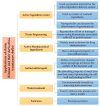Seafood Waste as Attractive Source of Chitin and Chitosan Production and Their Applications
- PMID: 32560250
- PMCID: PMC7349002
- DOI: 10.3390/ijms21124290
Seafood Waste as Attractive Source of Chitin and Chitosan Production and Their Applications
Abstract
Chitosan is a cationic polymer obtained by deacetylation of chitin, found abundantly in crustacean, insect, arthropod exoskeletons, and molluscs. The process of obtaining chitin by the chemical extraction method comprises the steps of deproteinization, demineralization, and discoloration. To obtain chitosan, the deacetylation of chitin is necessary. These polymers can also be extracted through the biological extraction method involving the use of microorganisms. Chitosan has biodegradable and biocompatible properties, being applied in the pharmaceutical, cosmetic, food, biomedical, chemical, and textile industries. Chitosan and its derivatives may be used in the form of gels, beads, membranes, films, and sponges, depending on their application. Polymer blending can also be performed to improve the mechanical properties of the bioproduct. This review aims to provide the latest information on existing methods for chitin and chitosan recovery from marine waste as well as their applications.
Keywords: biopolymer; biotechnology; chitosan blend; polysaccharide; shrimp waste.
Conflict of interest statement
The authors declare that there are no conflicts of interest regarding the publication of this article.
Figures






Similar articles
-
Acidic proteases from Monterey sardine (Sardinops sagax caerulea) immobilized on shrimp waste chitin and chitosan supports: searching for a by-product catalytic system.Appl Biochem Biotechnol. 2013 Oct;171(3):795-805. doi: 10.1007/s12010-013-0407-8. Epub 2013 Jul 30. Appl Biochem Biotechnol. 2013. PMID: 23897542
-
Isolation and optimization of the method for industrial production of chitin and chitosan from Omani shrimp shell.Carbohydr Res. 2020 Jun;492:108001. doi: 10.1016/j.carres.2020.108001. Epub 2020 Apr 2. Carbohydr Res. 2020. PMID: 32259704
-
Advances in extraction, utilization, and development of chitin/chitosan and its derivatives from shrimp shell waste.Compr Rev Food Sci Food Saf. 2024 Sep;23(5):e70008. doi: 10.1111/1541-4337.70008. Compr Rev Food Sci Food Saf. 2024. PMID: 39223761 Review.
-
Structural characterization of chitin and chitosan obtained by biological and chemical methods.Biomacromolecules. 2011 Sep 12;12(9):3285-90. doi: 10.1021/bm200750t. Epub 2011 Aug 5. Biomacromolecules. 2011. PMID: 21790136
-
Chitosan as a Valuable Biomolecule from Seafood Industry Waste in the Design of Green Food Packaging.Biomolecules. 2021 Oct 28;11(11):1599. doi: 10.3390/biom11111599. Biomolecules. 2021. PMID: 34827597 Free PMC article. Review.
Cited by
-
Exploring the Potential of Using Marine-Derived Ingredients: From the Extraction to Cutting-Edge Cosmetics.Mar Drugs. 2023 Nov 29;21(12):620. doi: 10.3390/md21120620. Mar Drugs. 2023. PMID: 38132941 Free PMC article. Review.
-
Odor Fingerprinting of Chitosan and Source Identification of Commercial Chitosan: HS-GC-IMS, Multivariate Statistical Analysis, and Tracing Path Study.Polymers (Basel). 2024 Jun 28;16(13):1858. doi: 10.3390/polym16131858. Polymers (Basel). 2024. PMID: 39000713 Free PMC article.
-
Chitosan with Natural Additives as a Potential Food Packaging.Materials (Basel). 2023 Feb 14;16(4):1579. doi: 10.3390/ma16041579. Materials (Basel). 2023. PMID: 36837209 Free PMC article. Review.
-
Antimicrobial properties of chitosan from different developmental stages of the bioconverter insect Hermetia illucens.Sci Rep. 2022 May 16;12(1):8084. doi: 10.1038/s41598-022-12150-3. Sci Rep. 2022. PMID: 35577828 Free PMC article.
-
Multifunctional Modified Chitosan Biopolymers for Dual Applications in Biomedical and Industrial Field: Synthesis and Evaluation of Thermal, Chemical, Morphological, Structural, In Vitro Drug-Release Rate, Swelling and Metal Uptake Studies.Sensors (Basel). 2022 Apr 30;22(9):3454. doi: 10.3390/s22093454. Sensors (Basel). 2022. PMID: 35591144 Free PMC article.
References
-
- Wang S.L., Nguyen V.B. Production of potent antidiabetic compounds from shrimp head powder via Paenibacillus conversion. Process. Chem. 2019;76:18–24. doi: 10.1016/j.procbio.2018.11.004. - DOI
-
- Liu C., Cai W., Cuixia Z., Ma M., Rao W., Li W., He K., Gao M. Developing the ecological compensation criterion of industrial solid waste based on energy for sustainable development. Energy. 2018;157:940–948. doi: 10.1016/j.energy.2018.05.207. - DOI
-
- Mohanty B., Mohanty U., Pattanaik S.S., Panda A., Jena A.K. Future prospects and trends for effective utilization of fish processing wastes in India. Innovat. Farm. 2018;3:1–5.
-
- Tsakanika A., Clauzet M., May P.H. Envolvendo os pescadores artesanais no desenvolvimento sustentável urbano e periurbano no Brasil. Revibec. 2018;28:1–20.
Publication types
MeSH terms
Substances
Grants and funding
LinkOut - more resources
Full Text Sources

